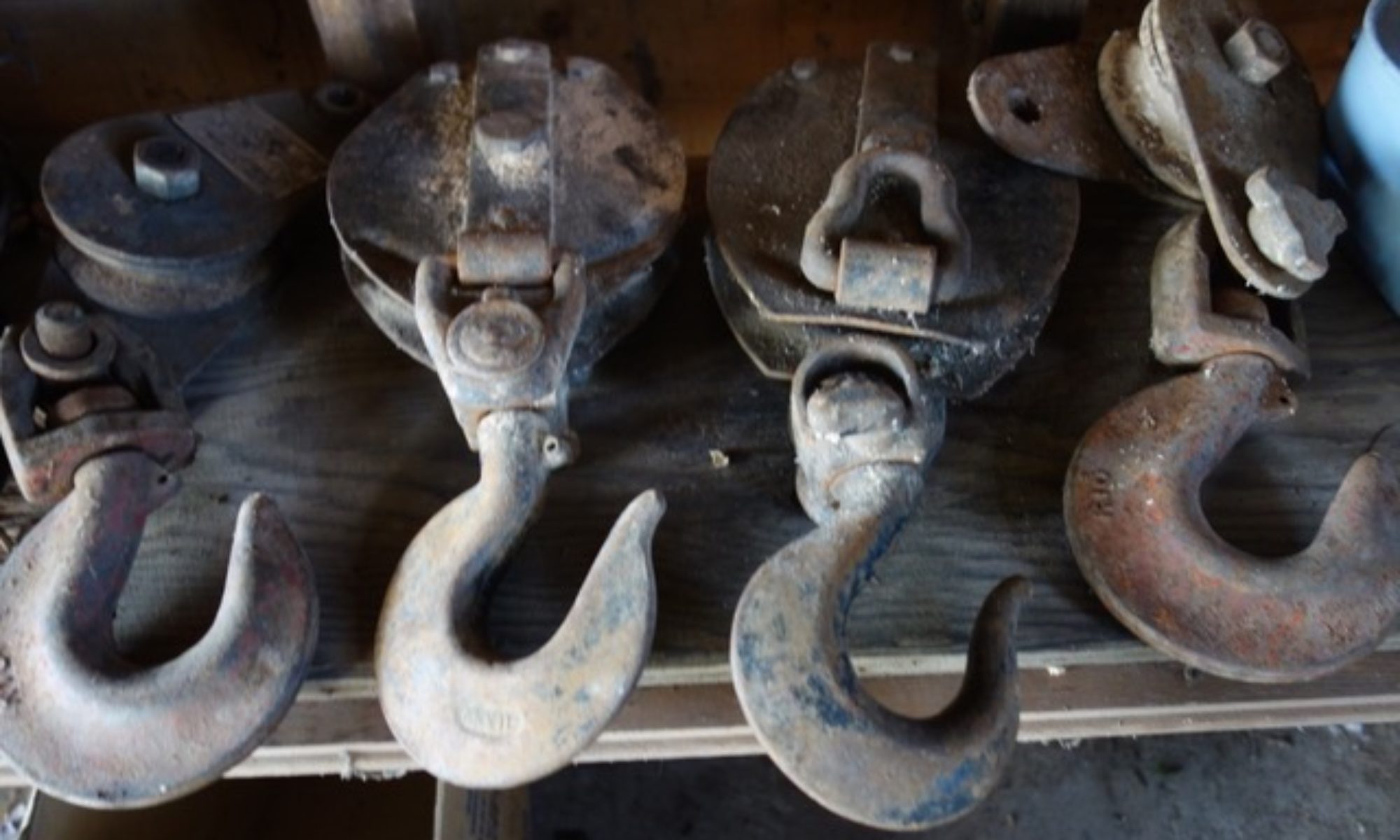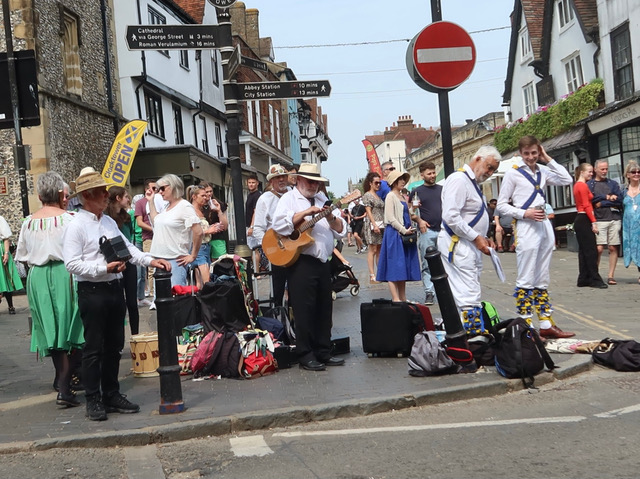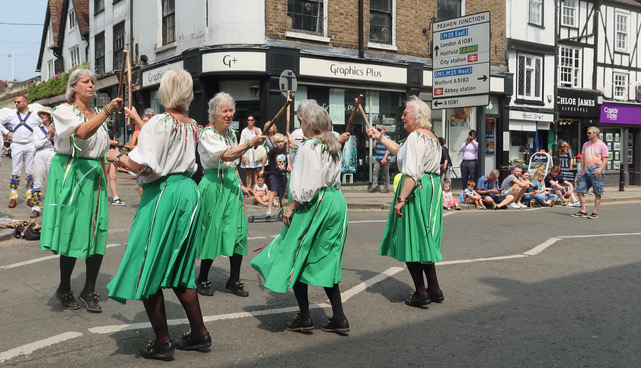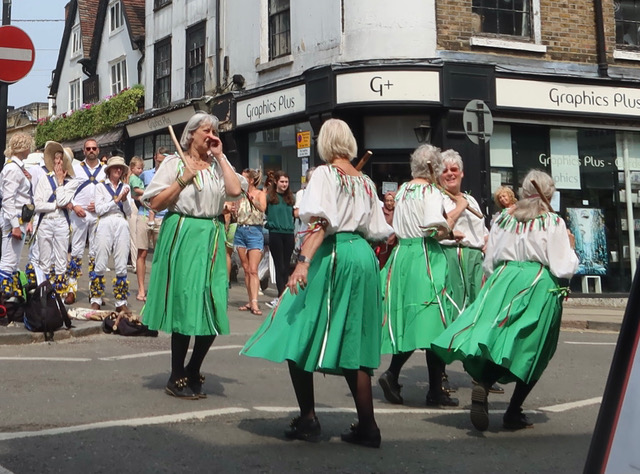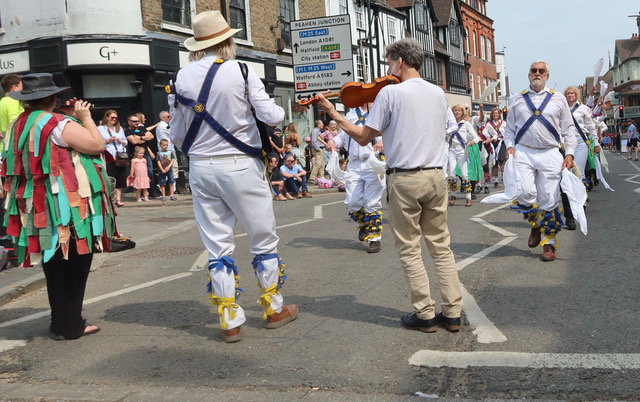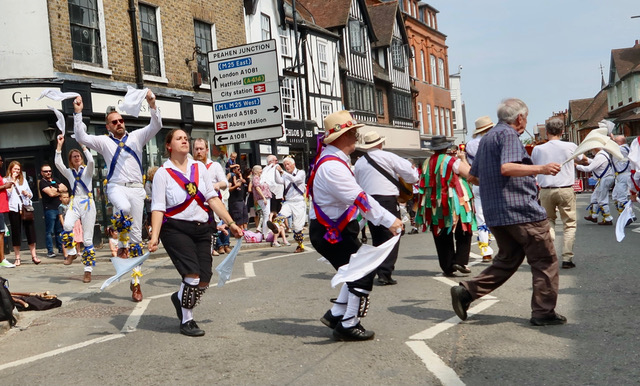EPISODE 849 MORRIS DANCERS…why do they jump about?
alan skeoch
june 2023
Morris dancing is a form of English folk dance usually accompanied by music. It is based on rhythmic stepping and the execution of choreographed figures by a group of dancers, usually wearing bell pads on their shins. Implements such as sticks, swords and handkerchiefs may also be wielded by the dancers.
WE MEET A BUNCH OF MORRIS DANCERS , june 2023
The village of St. Albans had closed off its main street for a bunch of senior
citizens in odd costumes…with bells on their ankles and either hitting each other with sticks
or leaping in the air and waving white handkerchiefs all in time with a violin and an accordion.
Big crowd had gathered.
Strange to see men leaping in unison while waving a white nose cloth. Even stranger to see
two rows of women in green dress trying to hit each other hunks of wood….while dancing .
“What’s happening?”
“I think these are Morris dancers?”
The name came to me although I had never seen such dancers before.
“Strangest dancers I’ve ever seen. Big men and big women acting as if they are light feathers.”
“Could you do it?”
“Not with my bad knee.”
“These dancers are 60 to 90 years old.”
“How do you know that?”
“By their haircolor or lack of hair.”
WHAT IS THE PURPOSE OF MORRIS DANCING?
“’Seems to have begun as a fertility thing way back in the 15th century.”
“Fertlility?”
“”Villagers wishing that their neighbours would get pregnant.”
“Did they not know the real facts of life,?
“Sex?”
“Yes. Getting pregnant and having healthy children is a matter of chance….it does not
happen that easily.”
“Are Morris dancers encouraging sexual activity?”
“Seems so….although the dancing could be a harvest wish……good crops?”
“Do you know what I really think?”
“Morris dancing is not a fertility blessing or a wish for good harvest….then what?’
“I think Morris dancing is just an excuse to have a good time with friends.”
“Now that makes sense.”
“Morris dancers used to be exclusively men for some reason but now both
sexes jump around.”
“I wonder why just men?”
“I have no idea but I bet there was a reason..”
“Find out…..(READERS JOB)
NOTE: My brother Eric and I did not need Morris Dancers to exlain the facts of life.
We had TINKER who attracted Tom Cats like a magnet does hairpins. She chose one,
struck an odd posture. The Tom Cat then crawled on fast and got away fast. Then
we had kittens….lots o of kittens. TINKER was a teacher. Her Tom Cat visitors lined
along the back fence and sang some sexual song in perfect harmony until dad fired
the bb gun from the kitchen window.
History in England
While the earliest (15th-century) references place the Morris dance in a courtly setting, it appears that the dance became part of performances for the lower classes by the later 16th century; in 1600, the Shakespearean actor William Kempe, Morris danced from London to Norwich, an event chronicled in his Nine Daies Wonder (1600).
Almost nothing is known about the folk dances of England prior to the mid-17th century. While it is possible to speculate on the transition of “Morris dancing” from the courtly to a rural setting, it may have acquired elements of pre-Elizabethan (medieval) folk dance, such proposals will always be based on an argument from silence as there is no direct record of what such elements would have looked like. In the Elizabethan period, there was significant cultural contact between Italy and England, and it has been suggested that much of what is now considered traditional English folk dance, and especially English country dance, is descended from Italian dances imported in the 16th century.
By the mid 17th century, the working peasantry took part in Morris dances, especially at Whitsun. The Puritan government of Oliver Cromwell, however, suppressed Whitsun Ales and other such festivities. When the crown was restored by Charles II, the springtime festivals were restored. In particular, Whitsun Ales came to be celebrated on Whitsunday (Pentecost), as the date coincided with the birthday of Charles II.
Morris dancing continued in popularity until the industrial revolution and its accompanying social changes. Four teams claim a continuous lineage of tradition within their village or town: Abingdon (their Morris team was kept going by the Hemmings family), Bampton, Headington Quarry, and Chipping Campden. Other villages have revived their own traditions, and hundreds of other teams across the globe have adopted (and adapted) these traditions, or have created their own styles from the basic building blocks of Morris stepping and figures.
However by the late 19th century, and in the West Country at least, Morris dancing was fast becoming more a local memory than an activity. D’Arcy Ferris (or de Ferrars), a Cheltenham based singer, music teacher and organiser of pageants, became intrigued by the tradition and sought to revive it. He firstly encountered Morris in Bidford and organised its revival. Over the following years he took the side to several places in the West Country, from Malvern to Bicester and from Redditch to Moreton in Marsh. By 1910, he and Cecil Sharp were in correspondence on the subject.
Several English folklorists were responsible for recording and reviving the tradition in the early 20th century, often from a bare handful of surviving members of mid-19th-century village sides. Among these, the most notable are Cecil Sharp, Maud Karpeles, and Mary Neal.
Boxing Day 1899 is widely regarded as the starting point for the Morris revival. Cecil Sharp was visiting at a friend’s house in Headington, near Oxford, when the Headington Quarry Morris side arrived to perform. Sharp was intrigued by the music and collected several tunes from the side’s musician, William Kimber; not until about a decade later, however, did he begin collecting the dances, spurred and at first assisted by Mary Neal, a founder of the Espérance Club (a dressmaking co-operative and club for young working women in London), and Herbert MacIlwaine, musical director of the Espérance Club. Neal was looking for dances for her girls to perform, and so the first revival performance was by young women in London.
In the first few decades of the 20th century, several men’s sides were formed, and in 1934 the Morris Ring was founded by six revival sides. In the 1950s and especially the 1960s, there was an explosion of new dance teams, some of them women’s or mixed sides. At the time, there was often heated debate over the propriety and even legitimacy of women dancing the Morris, even though there is evidence as far back as the 16th century that there were female Morris dancers. There are now male, female and mixed sides to be found.
Partly because women’s and mixed sides were not eligible for full membership of the Morris Ring, two other national (and international) bodies were formed, the Morris Federation and Open Morris. All three bodies provid
